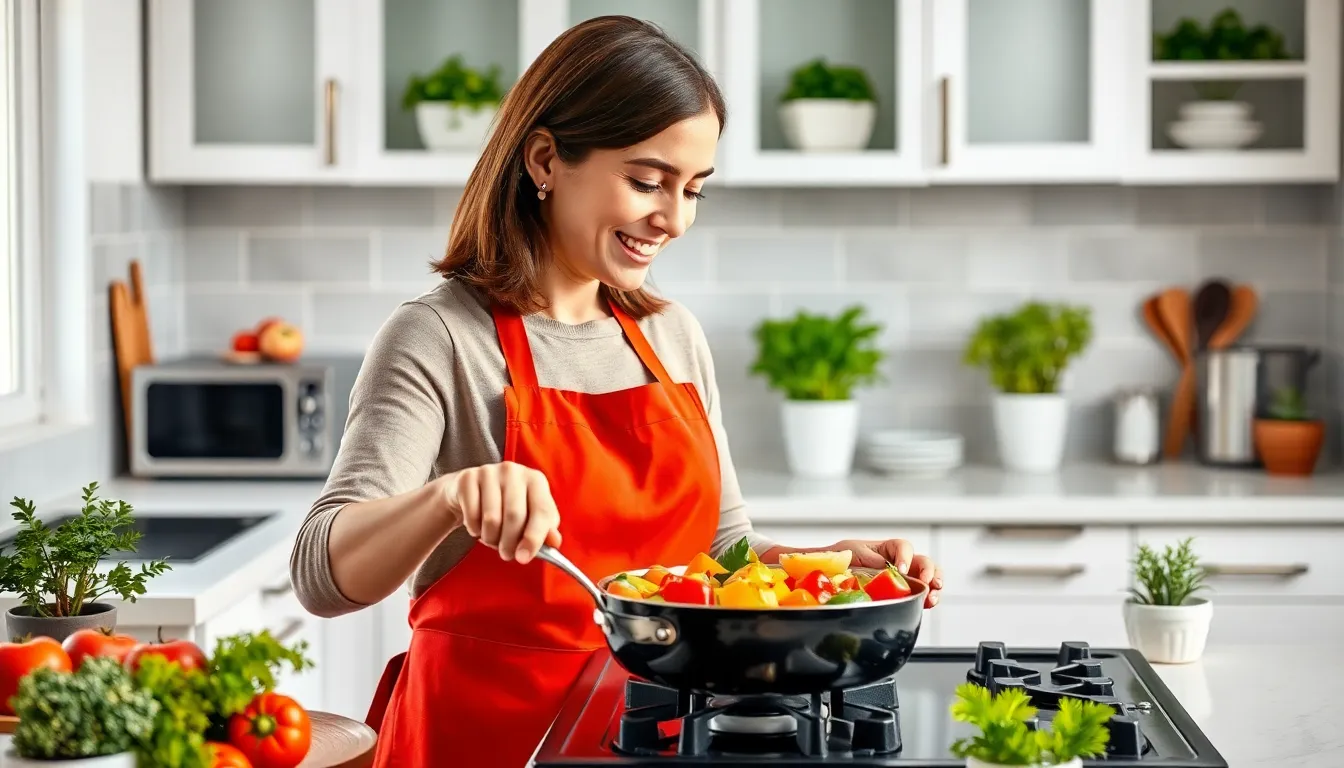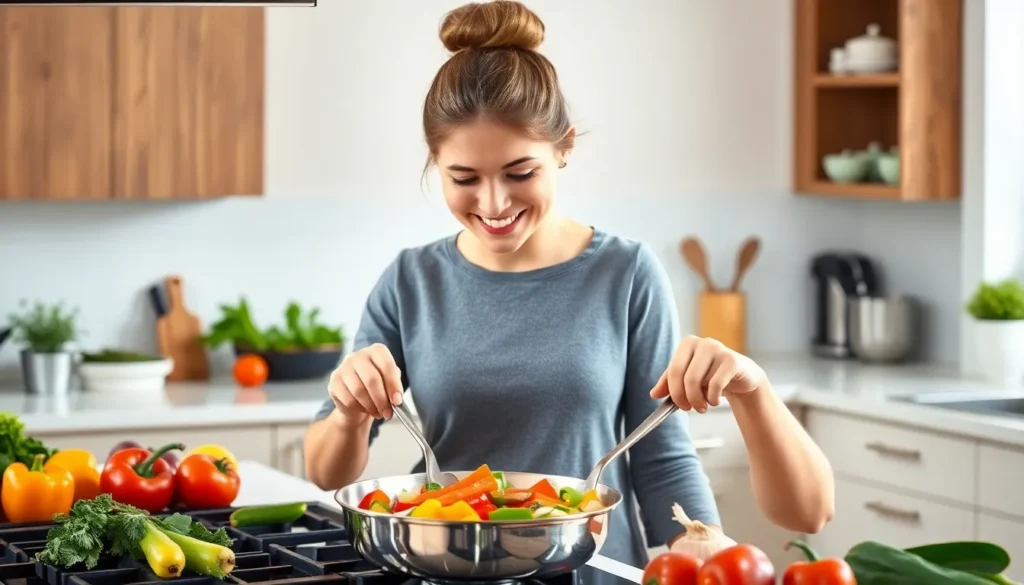In the culinary world, basic cooking techniques are like the secret handshake of a club no one knew they wanted to join. Mastering these skills not only elevates meals from mundane to mouthwatering but also saves the day when dinner plans go awry. Whether it’s sautéing like a pro or chopping onions without shedding a river of tears, these techniques are your trusty sidekicks in the kitchen.
Table of Contents
ToggleUnderstanding Basic Cooking Techniques
Mastering basic cooking techniques forms the foundation for successful meal preparation. Sautéing involves cooking food quickly in a small amount of oil over high heat, enhancing flavors while retaining moisture. Efficient chopping improves ingredient readiness, facilitating better organization and timing during the cooking process.
Boiling serves as another fundamental method, commonly utilized for pasta, rice, and vegetables. This technique cooks food by submerging it in water at high temperatures until it reaches desired tenderness. Steaming, known for preserving nutrients, uses vapor to cook food gently, promoting a healthy cooking style.
Baking requires dry heat in an oven, often essential for bread, pastries, and casseroles. This technique evenly distributes heat, creating a golden crust while maintaining moisture inside. Grilling imparts unique flavors through direct cooking over an open flame, ideal for meats and vegetables.
Roasting applies dry heat to larger cuts of meat or whole vegetables, resulting in rich caramelization. To achieve desired textures, flipping or stirring is often necessary during cooking. Braising combines moist and dry heat; food is first browned at high temperatures, then slow-cooked in liquid for tenderness.
Understanding these cooking techniques equips home cooks with essential skills. Familiarity with various methods offers versatility in preparing diverse cuisines. Mastery of these techniques not only simplifies meal preparation but also enhances overall culinary creativity.
Essential Cooking Methods

Understanding essential cooking methods expands a home cook’s culinary abilities. Mastery of dry heat and moist heat cooking techniques allows for a diverse range of dishes.
Dry Heat Cooking
Dry heat cooking employs methods that use air or fat to transfer heat. Roasting cooks food evenly, often enhancing flavor and texture. Baking applies dry heat to dishes like bread and pastries, relying on a consistent oven temperature. Grilling exposes food directly to a heat source, adding smoky flavors. Sautéing uses a small amount of fat, quickly cooking ingredients over high heat while retaining moisture. Each method offers unique results, contributing to the overall dish’s flavor and presentation.
Moist Heat Cooking
Moist heat cooking methods involve water or steam, ensuring moisture retention. Boiling submerges food in water or broth, effectively cooking vegetables and pasta. Steaming preserves nutrients and texture, making it ideal for delicate foods like fish and vegetables. Braising combines dry and moist heat, first searing ingredients before slow-cooking in liquid, enhancing tenderness and flavor. Poaching gently cooks food in water or broth, perfect for eggs or fruits, ensuring they stay tender and flavorful. Mastery of these techniques provides versatility and depth to a cook’s repertoire.
Common Cooking Techniques
Basic cooking techniques provide a foundation for successful meal preparation. Mastery of these techniques enhances flavors and improves presentation.
Sautéing
Sautéing involves cooking ingredients quickly in a small amount of fat. A hot pan is essential for achieving the desired browning without steaming the food. Vegetables like bell peppers and onions benefit from this technique, as they retain their crunch and vibrant color. Common fats used include olive oil, butter, and clarified butter. The process intensifies flavors while allowing natural moisture to escape. Stirring constantly ensures even cooking and prevents burning.
Boiling
Boiling cooks food by submerging it in bubbling water. A rolling boil is ideal for pasta and potatoes, ensuring they cook thoroughly. Adding salt enhances flavor, especially for starchy ingredients. Hearty vegetables such as carrots and green beans soften without losing their nutrients. Monitoring cooking time prevents overcooking, which can lead to mushiness. For delicate items like eggs, a gentle simmer provides optimal results, discouraging cracking.
Baking
Baking utilizes dry heat to cook food evenly throughout. An oven preheated to the right temperature is crucial for baked goods’ rise and texture. Bread and cakes benefit significantly from this technique, as it promotes even browning. The Maillard reaction occurs, enhancing both flavor and aroma. Baking trays and pans of various materials can affect cooking times, so awareness of these differences is vital. Precision in ingredient measurements determines outcomes, making baking both an art and a science.
Tips for Mastering Cooking Techniques
Mastering cooking techniques requires dedication and attention to detail. Practicing consistently leads to enhanced skills and increased confidence in the kitchen.
Practice and Patience
Practicing regularly improves technique proficiency. Cooking frequently allows individuals to experiment with different methods, refining their skills over time. Patience plays a vital role; cooking is as much an art as a science. With each attempt, cooks gain insights into flavors and textures. They learn how to adjust cooking times and temperatures to achieve desired results. Mistakes serve as essential learning experiences, informing better choices in future preparations.
Following Recipes
Following recipes offers a structured approach to learning fundamental techniques. Recipes provide step-by-step instructions that guide cooks through each process. Understanding ingredient measurements and cooking times ensures success. Cooks can experiment with variations once they gain confidence with standard recipes. Additionally, reading through the entire recipe before beginning helps identify potential challenges. It’s vital to understand the desired outcomes and incorporate necessary adjustments for improved results.
Mastering basic cooking techniques is essential for anyone looking to elevate their culinary skills. These foundational methods not only enhance the flavor and presentation of meals but also provide the confidence needed to experiment with new recipes. With practice and attention to detail, home cooks can turn everyday ingredients into extraordinary dishes. Embracing both dry and moist heat techniques opens up a world of possibilities in the kitchen. As they continue to refine their skills, cooks will find that the journey of culinary exploration is just as rewarding as the delicious meals they create.





